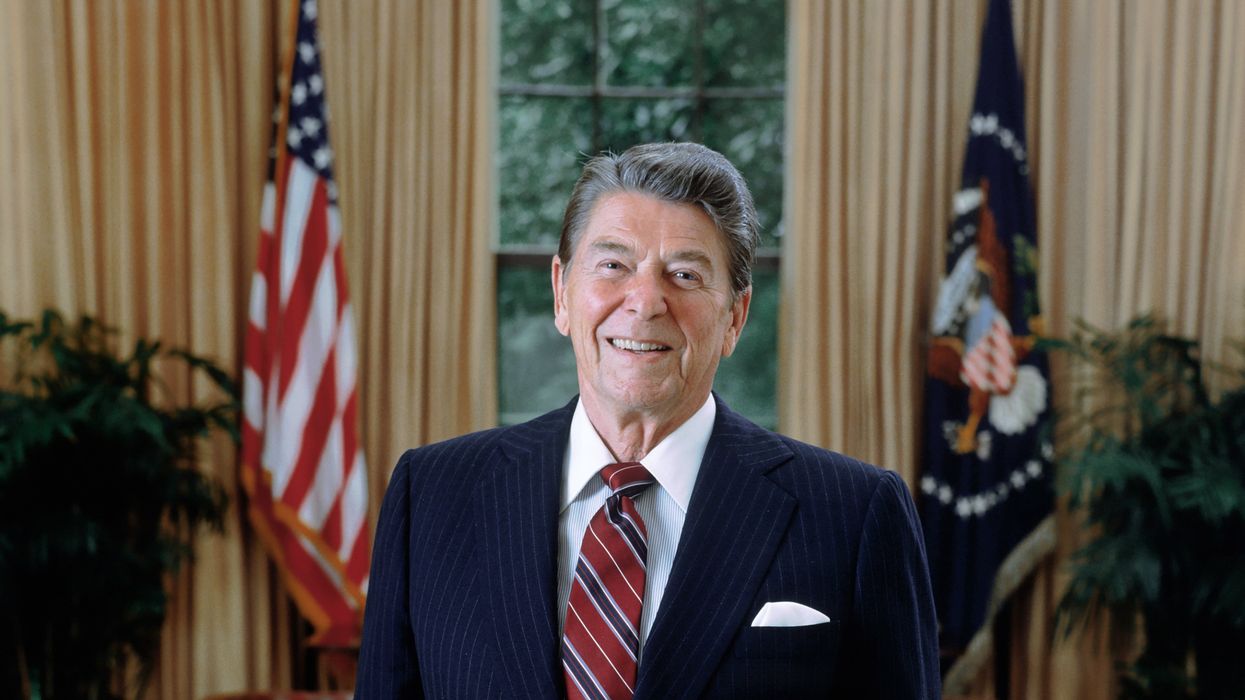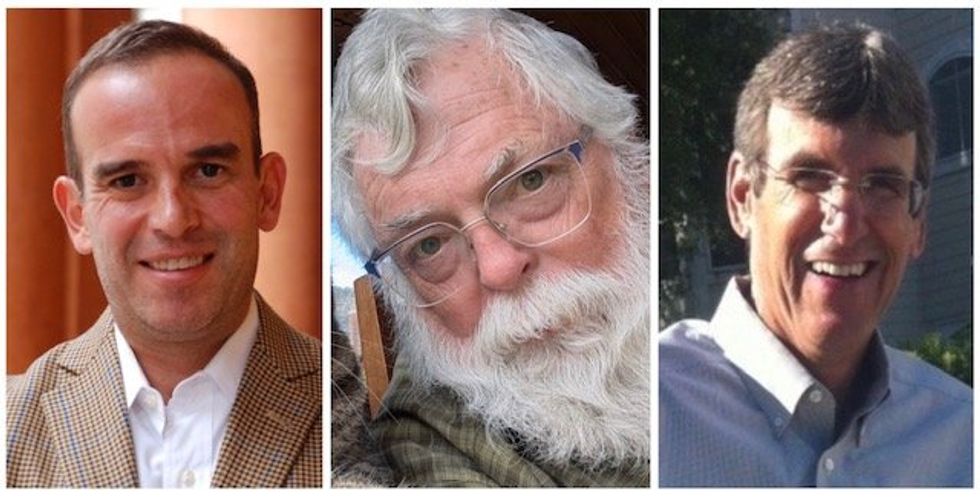Breslin is the Joseph C. Palamountain Jr. Chair of Political Science at Skidmore College and author of “A Constitution for the Living: Imagining How Five Generations of Americans Would Rewrite the Nation’s Fundamental Law.”
This is part of a series offering a nonpartisan counter to Project 2025, a conservative guideline to reforming government and policymaking during the first 180 days of a second Trump administration. The Fulcrum's cross-partisan analysis of Project 2025 relies on unbiased critical thinking, reexamines outdated assumptions, and uses reason, scientific evidence, and data in analyzing and critiquing Project 2025.
After 343,541 words of “Mandate for Leadership: The Conservative Promise,” the Project 2025 opus, we come finally to its very last. “Onward!” is the adverb Edwin Feulner, co-founder and former president of the Heritage Foundation, uses to close the conservative handbook.
“Our next mission,” he proclaims, “is just beginning. … Onward!”
It is a curious choice. It suggests a certain progress, a “moving forward,” a distancing from the past. The concept of advancing “onward” also supposes that the future journey will be brighter than the one we’re leaving behind. We are all pioneers forging “onward” to a more promising utopia. It is an eternally optimistic and hopeful word.
The irony of Feulner’s appeal for Americans to press “onward” is that his goal, and the goal of the complete roster of Project 2025 contributors, is to return to a time when America resembled more of a dystopia, when patriarchy ruled effortlessly, racism infused public policy and the blessings of liberty were, at best, disproportionately felt. Here I’m talking about the Reagan years.
Like so many old guard Republicans, Feulner is nostalgic for a period in the 1980s when Ronald Reagan was the party’s standard bearer. “The conservative movement had found in Ronald Reagan a President who shared [a conservative] vision and who had the will to go against the established political grain in Washington,” Feulner writes. “[Reagan] also had the ability to speak directly to the American people and convincingly show them how those ideas could work for the benefit of all.”
Feulner and the Project 2025 leadership are hoping that Donald Trump triumphs on Nov. 5 and the former president has the will, like Reagan, to “go against the established grain in Washington” by reintroducing Schedule F, reducing the federal government’s bureaucratic footprint, closing numerous agencies and departments, attacking personal freedoms, rejecting climate warnings, isolating America in an increasingly connected global world and accelerating the principle of a unitary executive.
They have reason to be optimistic; the similarities are scary. Among Reagan’s conservative accomplishments are the 1981 tax cuts that aimed to stimulate economic growth. Trump’s 2017 tax cuts (many of which Kamala Harris promises to retain) shared the same goal. Reagan deliberately and intentionally shifted the ideological balance on the Supreme Court to the right. So did Trump. Reagan used the power of the presidency to fire striking air traffic controllers. Trump recently doubled down on the exact same idea. It’s hardly surprising that Feulner looks to Reagan as the model Republican president.
And yet what Feulner and his Heritage Foundation collaborators fail to recognize (or at least fail to acknowledge) is that Reagan was deceptively ruthless — crafty and dishonest, really — to the detriment of the nation as a whole. His expansion of presidential power ushered in the modern unitary executive. Project 2025 hopes to build on that precedent. He fired civil servants who challenged him and filled those vacant positions with loyalists. Project 2025 encourages the same practice. He issued executive orders that extended his control over independent agencies. Project 2025 promises the same in the next Republican administration. He vetoed legislation that would have weakened the unitary executive. Project 2025 urges a similar practice.
On the international front, the 40th president went behind the back of Congress (and the American people) to accomplish his goals in the Iran-Contra affair. The Reagan administration secretly, and illegally, engaged in arms sales with the Iranians, and then proceeded to use the profits from those sales to prop up the Contras, a group of anti-socialist rebels in Nicaragua. The entire incident violated the law. Right on the heels of the Watergate scandal, it furthered the disquieting narrative that the president had become impervious to most legal guardrails. Sadly, the writers of Project 2025 don’t seem so bothered by that imperviousness.
Arguably, the most sinister Reagan initiative was his “war on drugs.” Racist through and through, the program’s target was low-level drug peddlers, many of whom were men of color. As Michelle Alexander persuasively shows, Reagan’s “war on drugs” was an attempt to control an entire population of young black men, a “New Jim Crow” as she calls it. Incarcerating millions of Black and Brown men under the auspices of being “tough on crime” allowed white elites to perpetuate systems of racial subordination, systems that resemble the more formal and overt structures of slavery and Jim Crow. Lock large segments of America’s racial minorities up and you permanently remove them from the political process. The result is the preservation of white authority.
Correspondingly, Project 2025 calls for a “restoration of law and order,” including increased sentences for minor violations, sacking prosecutors who are “soft on crime,” reinstating mandatory minimums and boosting the death penalty as a criminal justice tool. These are all policy changes that would disproportionately impact our Black and Brown neighbors.
“Onward!” Feulner implores. But to where? If the Project 2025 braintrust had its way, it would be “onward” to a past where progress around gender equality, racial equity, socioeconomic disparity, salary gaps, social justice, environmental fairness, government transparency, widespread tolerance and just plain decency were erased — a past where the power of white men always prevailed and the promises of America remained elusive.
Let’s choose a different path.
More articles about Project 2025
- A cross-partisan approach
- An Introduction
- Rumors of Project 2025’s Demise are Greatly Exaggerated
- Department of Education
- Managing the bureaucracy
- Department of Defense
- Department of Energy
- The Environmental Protection Agency
- Education Savings Accounts
- Department of Veterans Affairs
- The Department of Homeland Security
- U.S. Agency for International Development
- Affirmative action
- A federal Parents' Bill of Rights
- Department of Labor
- Intelligence community
- Department of State
- Department of the Interior
- Federal Communications Commission
- A perspective from Europe
- Department of Health and Human Services
- Voting Rights Act
- Another look at the Federal Communications Commission
- A Christo-fascist manifesto designing a theocracy
- Voters oppose the far-right playbook
- The Schedule F threat to democracy
- The Department of Justice
- A blueprint for Christian nationalist regime change
- How anti-trans proposals could impact all families
- The Federal Reserve
- A threat to equitable education
- Project 2025 policies are on the Nov. 5 ballot



















 From left to right: Gabriel Cardona-Fox, Bud Branch, Joe Concienne
From left to right: Gabriel Cardona-Fox, Bud Branch, Joe Concienne 